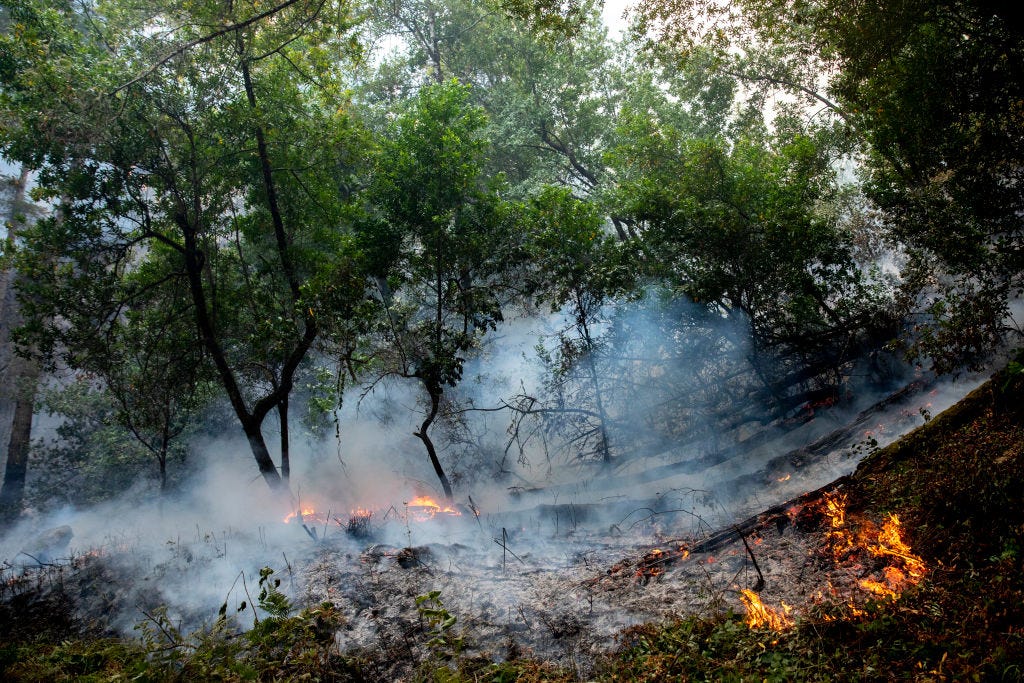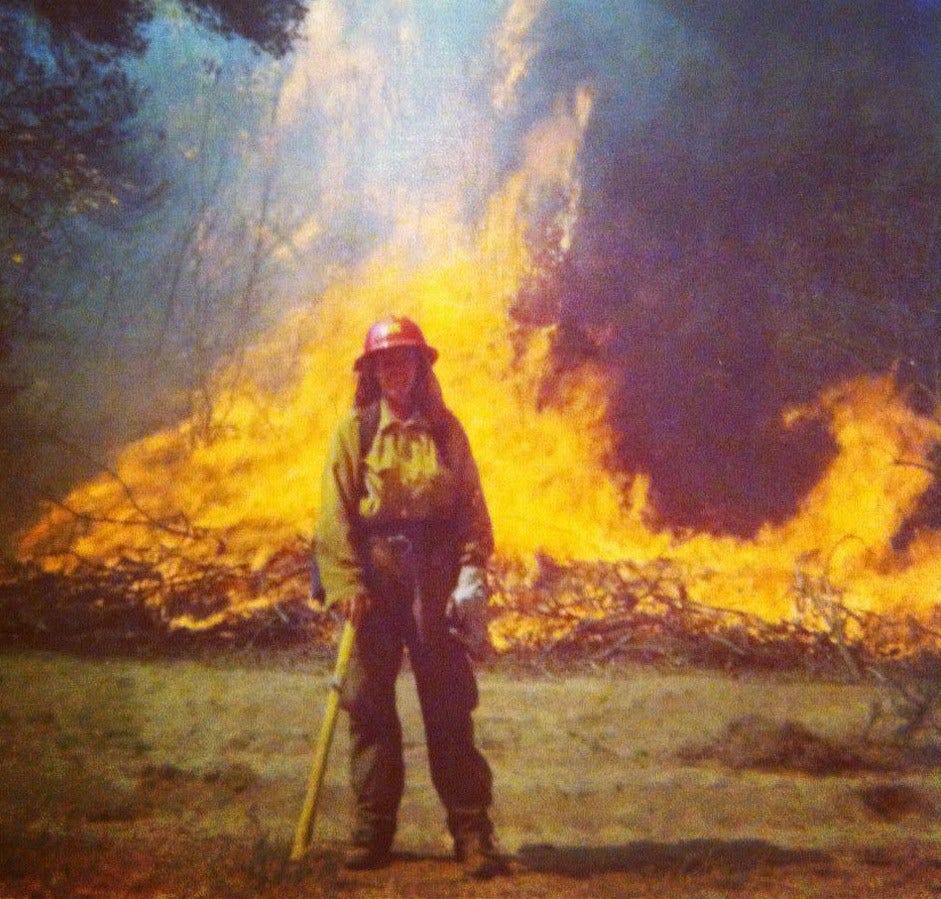This week, we interviewed Stacy Selby, who writes Fires, a publication about wildland fires and the issues surrounding them.
This interview has been lightly edited for length and clarity.
What's your Substack about in one sentence?
Fires is about the history of colonization and fire suppression and its intersection with the current state of fire in the United States (and beyond).
You spent seven years as a wildland firefighter, starting from age 19. What do you wish people understood about the experience of fighting fires on the ground?
I worked my way up from a contract crew to a spot on a hotshot crew, which is an elite firefighting crew. The job was grueling: 16-hour days for two to three weeks in a row, few breaks, early wake-ups, long jarring rides in crew buggies (small buses), plus all the stress that comes with working closely with 20 people. There is very little privacy; many crews sleep out in the open without tents.
The work often involves digging and cutting firelines to remove flammable materials and carrying out burning operations that help to prevent fire growth. Burning removes fuels and can be very effective but can also go awry. Crews often mop up fires that have burned through, leaving areas of heat that need to be extinguished. These days are long, spent walking in a grid over a landscape, contending with its topographical features. Crew members check for heat, often manually, removing gloves to feel around in the ash or dirt.
We always said “Hurry up and wait.” When a fire blew up, we were sometimes powerless. Other times, we’d be staging in various parts of the country with high fire danger, waiting for a call.
You went from combating fires to writing about them. What was that process like for you?
That was like my odyssey. As a firefighter, I knew I wanted to go back to school. I had dropped out of community college. But it was too expensive, and the academic schedule cut into my summers, which were for work. I wrote all the time. I kept small notebooks in the front pocket of my shirt and always had a pen.
In 2010, my mom died by suicide. This was life-changing. I couldn’t quit because she had been broke, and I didn’t have any savings, so I finished out the entire season. I kind of lost it. That was my last season.
A year later, my first short story came out in the New Ohio Review, and an editor there suggested I go to college. I applied to a few schools and got into Syracuse, with funding. That changed my life. I worked full-time through college and was eventually accepted into the MFA program at Syracuse to study fiction. I learned a lot about researching, and I use those tools both for the newsletter and for my upcoming book, which is also about these subjects.
I miss fire sometimes, but only in an abstract way. I miss having a job in the woods, but my experience as a minority was not always pleasant, and I don’t miss having to prove myself all the time, nor having my identity questioned or maligned.

What are the most pressing topics and debates going on within the fire community right now?
I think people are having important conversations about the negative impact of fire suppression; how suppression has gotten us to this volatile moment in time. It’s not just climate change (which is real!). Important conversations are happening around cultural fire, Indigenous fire, and how disastrous it’s been to have removed that integral tool (and people) from the fire-adapted landscapes to which it and they were related.
Recently, at the federal level, they are pushing for more stringent suppression. This is a terrible idea, though I can see how they got there. There is also a lot of dialogue about how we can make prescribed fire part of our toolkit rather than something that happens only when everything is aligned. We need to be putting as much energy (and money) into prescribed fire as we are into fire suppression, as well as other forest and land management tools.
There are also conversations regarding the culture of fire crews and agencies, which can be macho, sexist and racist, as well as movements to raise the pay and benefits of wildland firefighters. How can firefighters have work-life balance, mental health support, and time to spend with their families during fire seasons? These are some very important discussions.
You recently embarked on a 10-part series about the western United States before fire suppression. What are your goals for that series?
My goals are to educate my readers and also learn more myself. I have always been fascinated with what the United States was like before colonization, but looking at it through the lens of fire really allows me to understand more about our current moment ecologically and culturally, and the myriad mistakes people made as they arrived and imposed their European ideas of agriculture on land they deemed “wild.” The land wasn’t wild. It was beautiful precisely because it was, for the most part, well cared-for. I want to learn from that.
It’s been surprising to see how integral fire is and was to the entire United States, not just the West, as I used to think. I really want to write about some regions in the United States that aren’t as often associated with fire in the public eye, like Florida, the New Jersey Pine Barrens, and Alaska.

Fire season in the western U.S. now feels longer and more destructive. Are there any positive trends or promising ideas that are gaining traction around this issue?
One thing I am hopeful about is the cultural fire movement led by Indigenous people. I want this to gain more traction: for Indigenous people to be able to assume control over the lands that were stolen from them and for agencies, both state and federal, to trust that they often know what to do with their land and stop policing them.
I do think that there are a lot of promising ideas within the fire community. It’s hard to see them sometimes, because there are these monoliths of the Forest Service and the Bureau of Land Management and the Park Service, the three largest agencies that manage fire. Change happens incrementally within those agencies. But smaller communities are where change has to happen and is happening. Smaller communities need education about how to keep local forests and grasslands healthy and ensure their safety and the health of our planet.
Who's another Substack writer you'd recommend?
I love so many Substack writers! Alicia Kennedy is doing great work. I also love Jessica DeFino's The Unpublishable, Patti Smith's Substack, Welcome to Hell World, Maybe Baby, Kate McDermott’s Newsletter, John Paul Brammer’s ¡Hola Papi!, and Anne Helen Peterson’s Culture Study. And Heated (obviously).
Subscribe to Stacy’s newsletter, Fires, visit their website, and find them on Twitter and Instagram. You can also read their writing on their other Substack publication, Hermitage.



